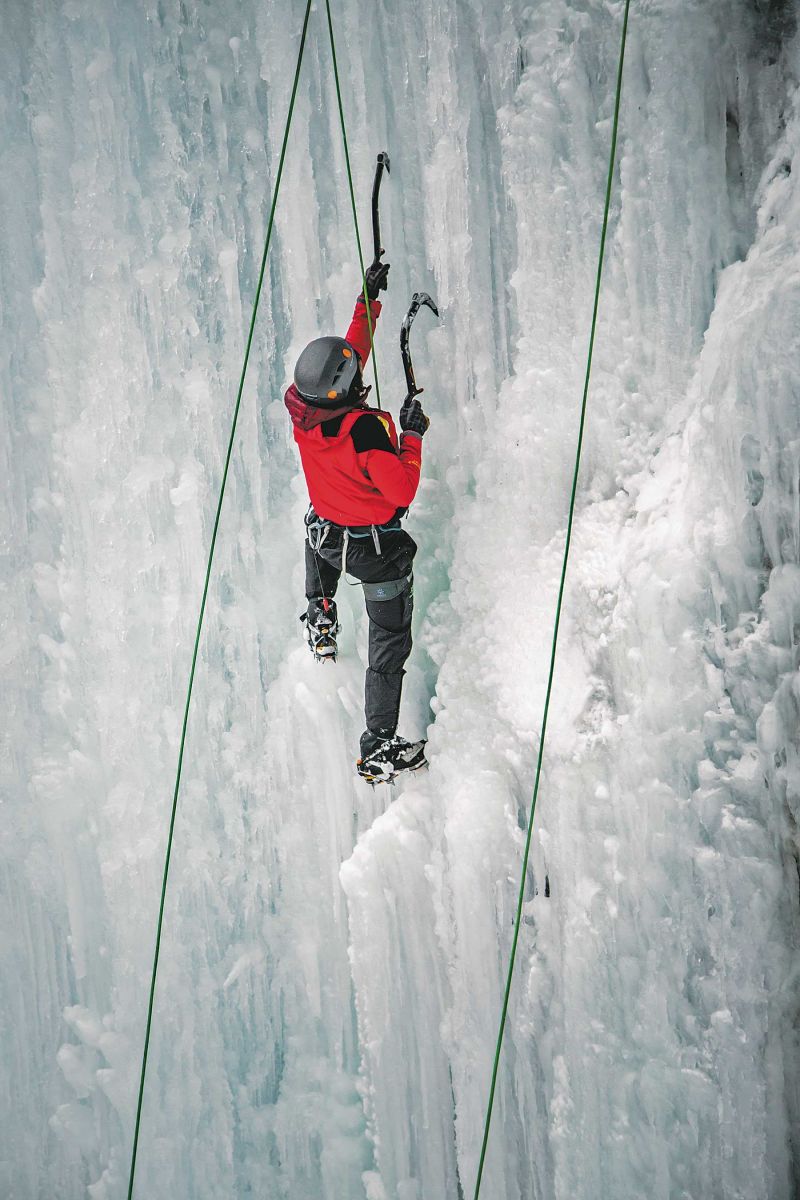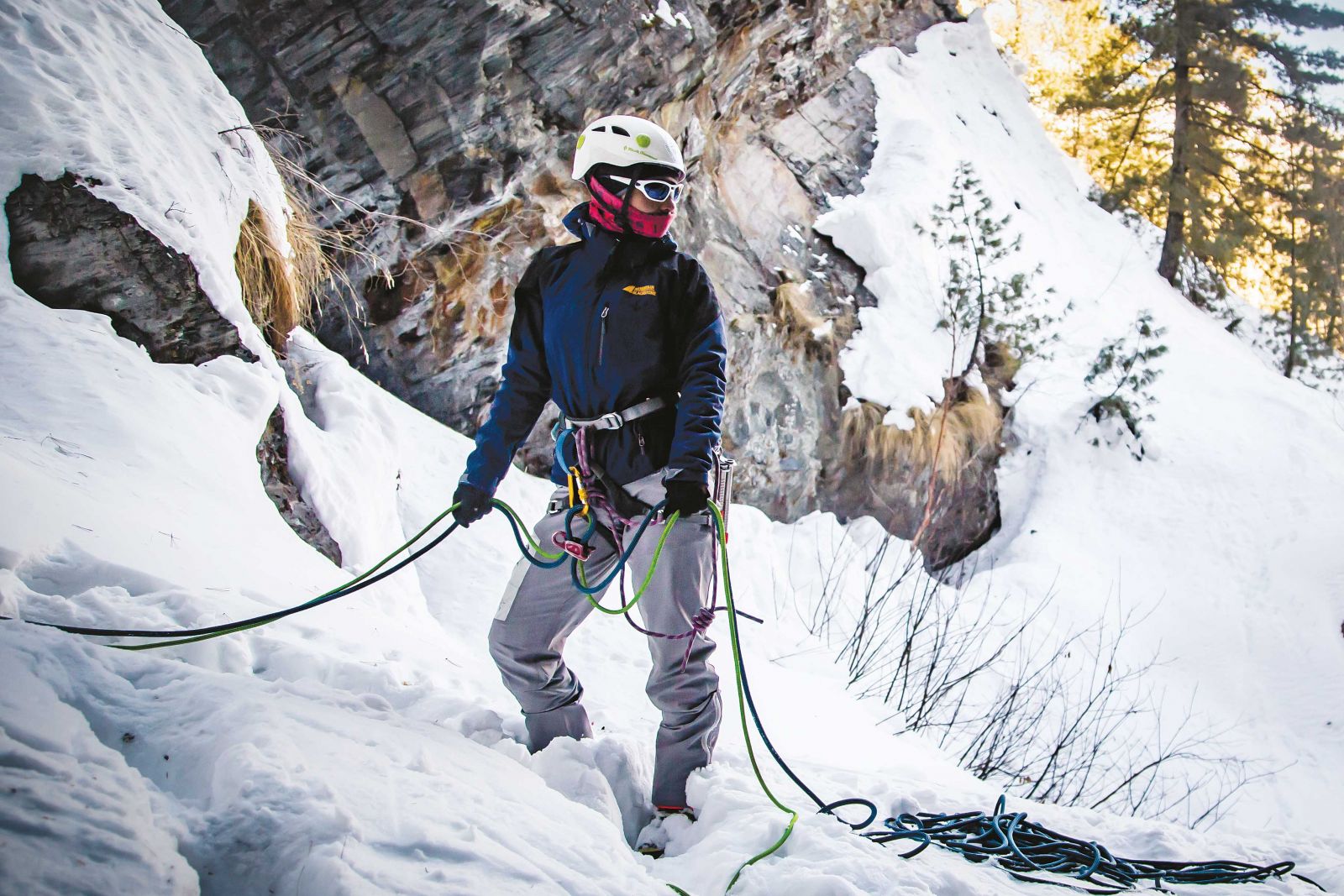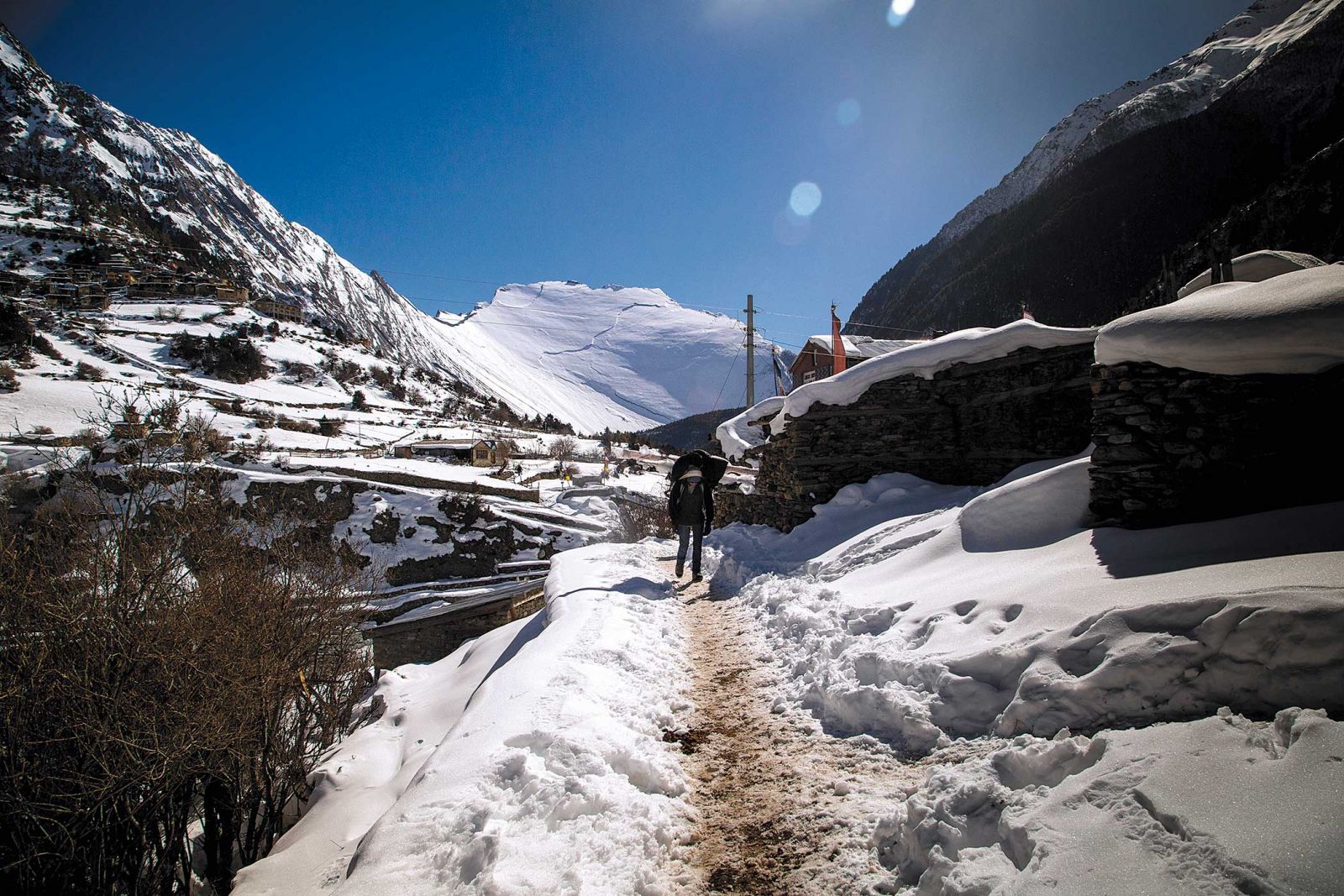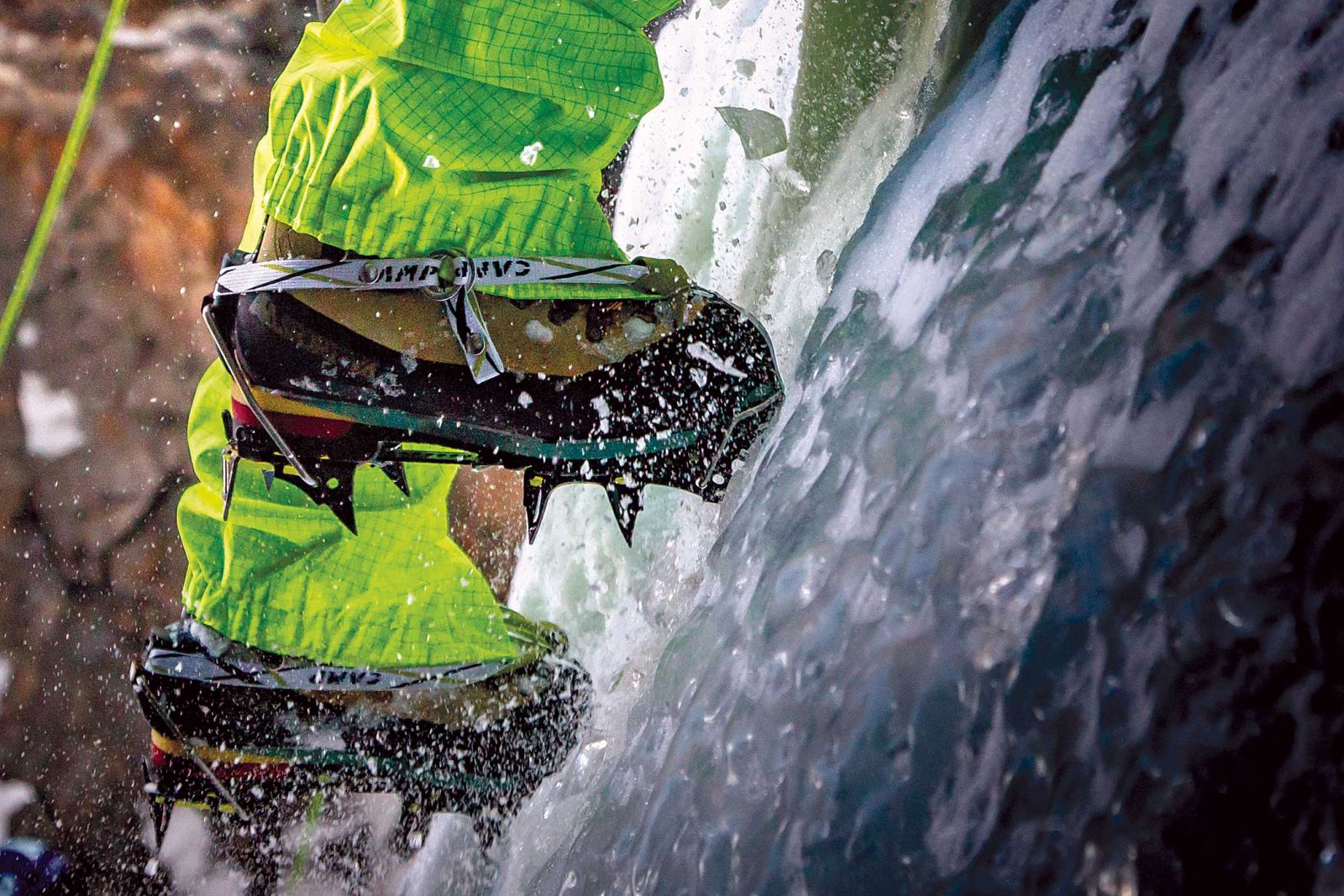Nepal Climbing Team’s first Ice Climbing Festival puts the Himalayas on the technical climbing map.
The static snapped sharply on the radio. Pasang Nuru Sherpa held up a gloved hand for quiet, as climbers shouted back and forth through the deep powder around us. It was day two of Nepal Climbing Team’s first Ice Climbing Festival. And we had no idea where the ice was.
Mountaineering and trekking are the bread and butter of Nepal tourism. Everest alone clocked over 800 summits last year, and over 200,000 trekking permits were issued by the Trekking Agencies Association of Nepal (TAAN). But technical rock and ice climbing are shockingly underdeveloped—the natural resources are there, but the human resources are not.
Nepal Climbing Team (NCT), a non-profit and non-governmental organization, is trying to shatter that ceiling.
 “Very few non-climbers know about rock and ice climbing, or think that it can be done by non-mountain climbers,” said Sangam KC, an NCT board member and assistant climbing instructor at the Khumbu Climbing Center. Founded by President Vinayak Jaya Malla and board members Dhurba Bista, Sangam KC, Mingma Sherpa, and Bishnu Tamang, NCT’s goals are to provide rising climbing athletes with opportunities and to promote technical rock and ice climbing. They recently held their first major event, an ice climbing festival, from Feb. 2 to 10 in Humde, Manang, a village located at about 3300 m altitude on the Annapurna Circuit.
“Very few non-climbers know about rock and ice climbing, or think that it can be done by non-mountain climbers,” said Sangam KC, an NCT board member and assistant climbing instructor at the Khumbu Climbing Center. Founded by President Vinayak Jaya Malla and board members Dhurba Bista, Sangam KC, Mingma Sherpa, and Bishnu Tamang, NCT’s goals are to provide rising climbing athletes with opportunities and to promote technical rock and ice climbing. They recently held their first major event, an ice climbing festival, from Feb. 2 to 10 in Humde, Manang, a village located at about 3300 m altitude on the Annapurna Circuit.
Organizers took participants up routes established by IFMGA guides Anup Gurung, Prem Gurung, and Vinayak Jaya Malla. Twenty Nepali and foreign participants attended, ranging from new climbers to certified mountain guides. I happened to be in Kathmandu when the organizers first told me about the festival. I’d walked the Annapurna Circuit last May, and I had climbed ice before, but I’d never mixed the two. I was intrigued.
But what is ice climbing? And how is it different from mountaineering? In mountaineering, reaching the summit of a mountain is generally the objective. Mountaineering may incorporate skills from technical ice and rock climbing. In technical ice climbing, the route itself is the objective. This route can consist of one rope-length (single-pitch climb) or more (multi-pitch climb). As such, technical climbing can occur at lower elevations and only cover certain sections of a peak.
Usually, ice climbers work in pairs with one person climbing on the top end of the rope and the other person belaying, or securing, the climber from below at the starting point of the pitch. In between, the climber and the belayer are various points of protection to catch the climber in case of a fall. Ice climbers bring the sharp points of two ice tools in their hands and two crampons on their feet into contact with the ice in order to climb up. The best way to get better? Practice, lots of it. Fortunately, that’s not a problem in Nepal. There’s plenty of ice to climb—if you can find it.
Pasang Nuru’s radio crackled sharply. The three of us waiting with him looked up. “We see the ice,” Vinayak radioed. “Left or right?” Left, Vinayak confirmed. Far left and up. Fair enough. From that point on there really was no right way, just the path of least resistance toward the right general direction of the ice flow. We had left the Annapurna Circuit trekking trail behind an hour ago to scramble along wet boulders dotting the river bank. Now, we were carving our own path through hip-deep snow. As we lifted each leg, the snow filled the spaces they left.
 Despite the unplanned route-finding, the excitement was palpable. We were definitely off the beaten path now and heading towards adventure. After all, what’s a proper climbing trip with a bit of uncertainty thrown into the adventure? Besides, we were never in any danger: the mountain guides working the festival made sure of that. As we walked, the climbers who had fanned out searching for the ice fell in with us. Just when it seemed like we couldn’t bushwhack up any farther, we caught our first glimpse of the wall. It was blue and beautiful. Stunning cauliflower ice spilled over a 15-meter high rock wall in front of us: the ice had formed in an uneven spray of water and air and solidified in cauliflower-like lumps at the tops of long icicles.
Despite the unplanned route-finding, the excitement was palpable. We were definitely off the beaten path now and heading towards adventure. After all, what’s a proper climbing trip with a bit of uncertainty thrown into the adventure? Besides, we were never in any danger: the mountain guides working the festival made sure of that. As we walked, the climbers who had fanned out searching for the ice fell in with us. Just when it seemed like we couldn’t bushwhack up any farther, we caught our first glimpse of the wall. It was blue and beautiful. Stunning cauliflower ice spilled over a 15-meter high rock wall in front of us: the ice had formed in an uneven spray of water and air and solidified in cauliflower-like lumps at the tops of long icicles.
As we started putting on our gear, Vinayak said with a wry smile that the path to the climbing area looked very different three years ago when it wasn’t covered in deep snow. In fact, that was the last time—to his knowledge—anyone had climbed in this particular area. I gaped. Where I learned to climb ice in New England, it was always a rush to tick off the climbs when they formed—before the ice was pockmarked with ice tool and crampon marks. Pristine ice was generally remote or rare.
“There are many local areas with great natural resources for climbing,” Prem said, as we sat in the afternoon sun outside our teahouse in Humde. “But not many people climb.” This was the first day of the ice festival, and the sun was a welcome contrast to the deep snow earlier that day when we took the new climbers out for their first climbs. Prem is an International Federation of Mountain Guides Association (IFMGA) certified guide. This is the most advanced level of qualification offered by the Nepal Mountaineering Instructors Association (NMIA). With the IFMGA qualification, Prem can guide mountains almost anywhere in the world. In fact, he’s had invitations from friends in Europe for the past three years. Invitations he routinely turns down.
“I want to work with my team to develop areas here while working with the locals,” Prem said. Instead of focusing on over-crowded, established tourist areas, he continues, this brings revenue directly to local communities. His team consists of his former students Anup and Vinayak, now both also IFMGA guides. Together, they’ve explored much of the Manang area over the past three to four years and put up numerous first ascents on single- and multi-pitch routes. The lines are mostly graded WI4 and WI5, meaning the climbs involve waterfall ice, which is vertical with few rest spots. The exception is the beginner’s climbing area Prem and I climbed that first day: the low-angle ice was great for learning crampon and ice tool placements.
 Two years ago, Prem realized, “I had all the gear and the knowledge. What is the point in just storing it?” The best way to pass on this knowledge was to throw an ice climbing festival and introduce domestic and foreign climbers to Manang’s natural resources. He wanted to make the festival an inclusive event where men and women, first time climbers and advanced guides, Nepali and foreigner alike all felt welcomed.
Two years ago, Prem realized, “I had all the gear and the knowledge. What is the point in just storing it?” The best way to pass on this knowledge was to throw an ice climbing festival and introduce domestic and foreign climbers to Manang’s natural resources. He wanted to make the festival an inclusive event where men and women, first time climbers and advanced guides, Nepali and foreigner alike all felt welcomed.
He looked towards big ice festivals in Innsbruck and Ouray as inspiration. Those festivals drew crowds from around the world, providing ice climbers with an arena to hone their skills and also a stage to showcase their athletic achievements. Reiterating Sangam’s point, he said, “We need to slowly change the perception of climbing in Nepal. We’re not just peak climbers, we’re athletes.”
But, the road to the ice climbing festival this year wasn’t that smooth. Prem quickly hit a few organizational and local road bumps. “Climbing always has an impact on the local community,” he said. The first task was to get the locals onboard with the idea of ice climbing. The process, he said, was to build up mutual trust and show the potential benefits. Maybe if his team and NCT do it correctly, he said, it can be a positive impact on the community. As for organizational hiccups, he realized he didn’t have the manpower to organize, secure sponsorship, promote, and host a festival by himself. A year ago, the situation changed: Vinayak brought NCT onboard.
With NCT behind them, the festival slowly came together. Sponsors, including Khukri Rum, offered their support for the vision. Though they had very limited resources at their disposal to hold the festival, NCT board members offset the costs to ensure the success of their first annual ice climbing festival.
“This year, we’re just starting,” Bishnu, NCT board member, said. “Maybe it will take a few years to become big, but we can make the foundations. Next year will be even better.”
The plan was simple: an 8-day festival, including the travel time it took to get from Kathmandu to Humde by bus and jeep. Get to the destination quickly and get as much climbing in as possible. The mountains, as usual, had no room for human plans. In the week leading up to the festival, a storm dumped over a meter of snow on the road leading up to Humde.
The vehicles couldn’t take us all the way to the teahouse. We’d have to go in on foot, a two-day walk each way. But, in a common theme which ran throughout the festival amongst organizers and participants alike, the response to adverse weather conditions was positive. When the going got tough, we all rolled up our sleeves and met the challenges head-on. As one participant remarked, we were there to climb ice. Not to be comfortable. The conditions, he said, made the festival seem more alpine in nature and gave us another chance to push ourselves harder. Yet, even as we pushed hard and walked through snow and icy patches to Humde, the ethos was “leave no man behind.”
 We had all come to the Ice Climbing Festival with different abilities: some were trained mountain guides, others were trekking guides. Some were rock climbers, others had been promised some skiing in the downtime from climbing. Some had never even been trekking before. After walking for two days towards the climbing area near Humde, we were old hands at the trekking game. We quickly developed a routine. Wake around 6:30, breakfast around 7, out the door by 7:30 or 8:00.
We had all come to the Ice Climbing Festival with different abilities: some were trained mountain guides, others were trekking guides. Some were rock climbers, others had been promised some skiing in the downtime from climbing. Some had never even been trekking before. After walking for two days towards the climbing area near Humde, we were old hands at the trekking game. We quickly developed a routine. Wake around 6:30, breakfast around 7, out the door by 7:30 or 8:00.
And at the end of each long day, we would dry our boots by the stove in the dining area of the next guesthouse. With the warmth slowly returning to our fingers, toes, and cheeks, we’d wait as Vinayak detailed the plans for the following day. Once we reached Humde, the participants were split into two groups each night: one geared towards teaching and reinforcing beginner skills; the other to allow more advanced climbers to hone their skills on newly-established routes.
The first climbing day of the festival, I followed Prem as he guided new climbers to some low-angle ice. On the second day, after bushwhacking to the stunning ice, I was itching to climb.
As Pasang Rinzee Sherpa led the first line and made a top rope anchor, his movements were smooth and methodical, sporadically punctuated by warning shouts of “Ice!” followed by small sharp shards showering us as we watched from below. Then, his pick broke through some thin ice. He gasped and we gaped as water came streaming out.
“Free shower!” Pasang Rinzee grins and climbs around it. By the time he’s on the ground once more, he’s soaked, or he would have been without his outer jacket. Climb the other top rope, he advises me, or enjoy your first shower in about 5 days. I opted for the shower.
The climb started out with big knobs I could practically grab onto with my gloved hands and nice solid sections for the crampons on my feet. Swinging both ice tools into the ice above my head, I could lift my feet one at a time to kick into the ice. With each kick, the two vertical frontpoints of my crampon would crunch into the ice. By dropping my heels just a bit, I could bring the other two points on the front of my crampons into contact with the ice. Standing up on both feet, I could move the tools in my hands upwards once more.
As I climbed, however, the rope stretched taut in front of me, securing me to the anchor above, and the ice grew thinner and more delicate. Soon, I knew exactly what Pasang Rinzee had meant by the “free shower.” Freezing water gushed through the thin ice wherever there were holes made by previous climbers. By the time I reached the top, my forearms were pumped, I was exhilarated, and my rain jacket was struggling to stay waterproof. Though the day had not gone exactly according to plan, it was a solid start.
Thanking all the participants on the last day of the festival, NCT board member Dhurba said, “For next year, we hope to have more participants, and we’ll organize a grand ice climbing festival.” In the works are longer routes, training clinics, and possibly a top rope and lead ice-climbing competition. Of course, right now these are just hopes and dreams which depend on landing sponsorship deals. With these goals for the future, NCT wrapped up its first ice climbing festival. The scrappy organizers and participants faced down bad weather, navigated sponsorship challenges, and embraced adversity to have a fun and successful time climbing in Humde, Manang. Perhaps you’ll be with us next year.
Contact the Nepal Climbing Team at http://www.nepalclimbingteam.org/ or nepalclimbingteam@gmail.com
Emile Young is an American photojournalist currently based in Copenhagen. She is an avid rock climber and adventurer with a passion for connecting people and learning about different cultures. Check out her website, https://offrouteonadventure.com/, or get in touch at emile@offrouteonadventure.com.











